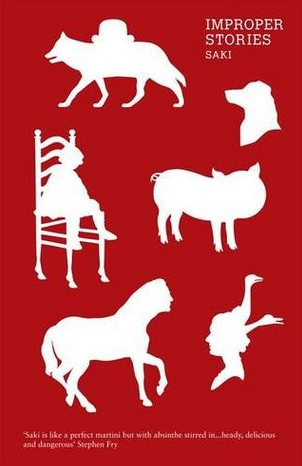

A week ago, I dealt with a novel among whose characters numbered one improperly termed a ‘monster’.
Now I want to look at a whole cluster of monsters that populate an improper collection; monsters, grotesques and sycophants that populate the Improper Stories of Hector Hugh Munro, or Saki.
These stories are all like fairy tales. Seemingly simple, but with subtext that is deeply subversive. Indeed, these tales were particularly subversive in their day because, for the Edwardians, the form was still much in use for the moral instruction of its youth. However, before continuing with the stories themselves, there is the matter of their writer and his nom de plume.
As I glance at the book, my eyes drawn to a quote by Stephen Fry, conveniently placed across the front cover: “Saki is like a perfect martini with absinthe stirred in… heady, delicious and dangerous”. I don’t know that Saki was intended as a homophone, yet with the distorting, and even disorienting, quality of the prose, I cannot help wonder if our author was attempting self-commentary, with an oblique reference to the Japanese rice wine sake.
In examining the distortions that fill these pages, I shall start at the beginning; this way limiting the scope of the spoilers. Still, even before coming to that, there is still another area of speculation to address. Subject to equal, if not greater speculation, than his pen name is Saki‘s sexuality. Speculation of this sort can be an irritating past time, where those who partake have dubious motives. Still, at a time when primitive views persist, it is worthwhile drawing attention to the various achievements of LGBT people, confirmed and unconfirmed. Still, for author Christopher Hitchens, there is no doubt: “There is nothing about which to speculate. He was self-evidently homosexual and, just as obviously, deeply repressed.”
[SPOILERS AHEAD!]
All the stories are satires of one sort or another. Even so, ‘The Story-Teller’, the first story in this collection, sets up the use to which these types of story were set. We begin in a train carriage where a group of children are bored and restless. The long suffering aunt endeavours to quell her charges by telling them a story, but makes little progress with a story that attempts to instil the behaviours so lacking in her brood. Following her dismal attempts, another passenger attempts to shut them up. This stranger tells a story that begins in a similar vein. He tells of a girl named Bertha, whose good behaviour is rewarded with medals, and of a Prince who further rewards her by allowing her to walk in the royal park once a week. One day, Bertha is out walking in the park when along comes a great wolf – enter the archetypal monster – and she hides so as to escape the wolf’s notice. Yet in her fright, the young girl trembles, causing her medals to clink against one another. Hearing this, the wolf drags her off for supper. The children are delighted by this bloody tale but the aunt is not, and complains to the stranger who remarks that with his story, “kept them quiet for ten minutes, which is more than you were able to do”.
We begin in a train carriage where a group of children are bored and restless. The long suffering aunt endeavours to quell her charges by telling them a story, but makes little progress with a story that attempts to instil the behaviours so lacking in her brood. Following her dismal attempts, another passenger attempts to shut them up. This stranger tells a story that begins in a similar vein. He tells of a girl named Bertha, whose good behaviour is rewarded with medals, and of a Prince who further rewards her by allowing her to walk in the royal park once a week. One day, Bertha is out walking in the park when along comes a great wolf – enter the archetypal monster – and she hides so as to escape the wolf’s notice. Yet in her fright, the young girl trembles, causing her medals to clink against one another. Hearing this, the wolf drags her off for supper. The children are delighted by this bloody tale but the aunt is not, and complains to the stranger who remarks that with his story, “kept them quiet for ten minutes, which is more than you were able to do”.
The story perfectly encapsulates the hypocrisy of the reward ethics intended for the edification of Edwardian children. Bertha’s medals, the form of her approbation, prove the cause of her death. By the same token, the Edwardians wanted their children to be seen and not heard, yet lacked the will to supply the required stimulation, as it conflicted with the need to instill good habits in those same kids. The story, and the story within the story, demonstrate the hypocrisy of these attitudes. For anyone in any doubt as to whose side Saki was on need look no further than the opening description of the hapless aunt “belonging to the children”. It’s fair to say that, having been owned, auntie then gets owned.
For all those that like to indulge in supernatural tales, these dark and grizzly stories will surly make for enticing reading. Tart with a metallic after taste.










